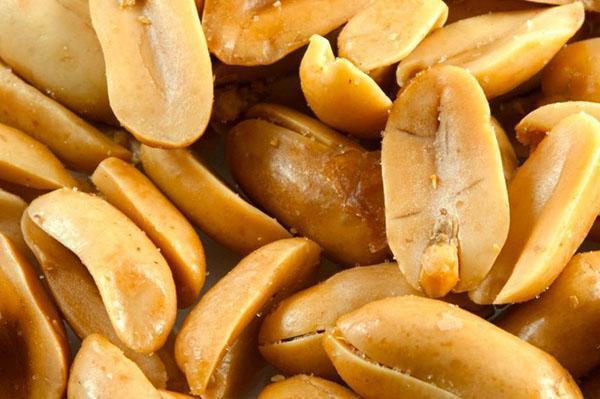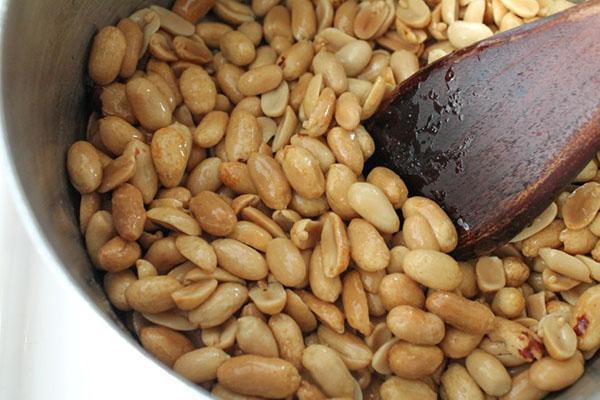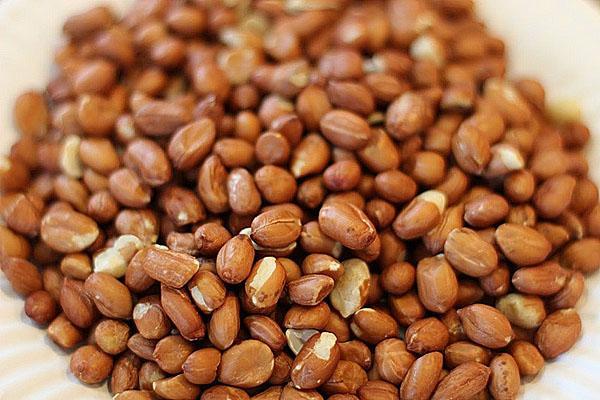How to fry peanuts in a pan, oven and microwave
 Those who love homemade snacks often wonder how to fry peanuts in a pan? The cost of nuts in the store is relatively low, but in the composition, except directly peanuts there may be absolutely unnecessary additives. Therefore, it is better to try making a treat at home.
Those who love homemade snacks often wonder how to fry peanuts in a pan? The cost of nuts in the store is relatively low, but in the composition, except directly peanuts there may be absolutely unnecessary additives. Therefore, it is better to try making a treat at home.
On this topic:peanut butter - benefits and harms for the body!
How to fry peanuts in a pan?

- Pour oil into a thick-walled frying pan with high sides.
- Put on high heat (or on an electric stove heated to maximum temperature) for about a minute.
- Fill in the nuts and reduce the heat to almost a minimum (hot oil keeps the temperature for a long time, so the contents of the pan will simply burn out over high heat).
- Fry, stirring constantly, for about 5 minutes.
Peanut should darken and, with a slight pressure, easily split into two halves. For your own comfort, try one nut to make sure it is ready. Then carefully drain off the hot oil. Those who do not know how to fry peanuts in a pan with salt should do all of the above steps. Salt is added to the hot peanuts after the oil has been drained.
Roasting, by itself, enhances the flavor of the peanuts. But for additional flavoring, you can add salt with spices, dried herbs.
Since you cannot fry peanuts in a pan without oil, people who monitor cholesterol levels should pay attention to other cooking methods.
Find out, how to roast chestnuts?
Roasting peanuts in the microwave
 Of course, to get nuts "like from a pack" you need to fry them in a pan. But if you do not want to spend a lot of time preparing a snack, then it is worth learning about how to fry peanuts in the microwave. It should be noted right away that the nuts will not be fragrant, but the roasting process will take a minimum of time.
Of course, to get nuts "like from a pack" you need to fry them in a pan. But if you do not want to spend a lot of time preparing a snack, then it is worth learning about how to fry peanuts in the microwave. It should be noted right away that the nuts will not be fragrant, but the roasting process will take a minimum of time.
You will need:
- raw peeled peanuts: 500 grams;
- salt to taste;
- a tablespoon of vegetable oil.
Place the nuts in a deep, microwave-safe saucepan. Sprinkle with salt, drizzle with oil and mix thoroughly. Turn on the oven at a power of 1100 W. The total cooking time is 7 minutes. But after about 5 minutes after starting the cooking process, you need to stir the contents of the saucepan to obtain a more uniform taste.
When roasting peanuts in the microwave, be sure to use containers with lids. Nuts tend to fly apart. Inshell peanuts should not be placed in the microwave at all.
It is worth preparing for the fact that hot peanuts from the microwave will not have the characteristic roasted taste and smell. Hot nuts can even feel damp. But in fact, seven minutes is quite enough for a complete heat treatment of the product.
How to cook peanuts in the oven?
 The oven is a great solution for those who do not like fatty snacks from the pan, and the taste of nuts from the microwave seems too bland. Before roasting peanuts in the oven, you need to prepare 500 grams of nuts, foil or oiled parchment.
The oven is a great solution for those who do not like fatty snacks from the pan, and the taste of nuts from the microwave seems too bland. Before roasting peanuts in the oven, you need to prepare 500 grams of nuts, foil or oiled parchment.
- Heat the stove to 180 C.
- Spread the nuts in one layer on foil or parchment.
- Salt.
- Place in the oven for 20 minutes.
The oven will also be an option for those who don't know how to roast peanuts in shell. Indeed, when frying in a frying pan, the shell will simply be oiled, and the nuts will remain raw from the inside. Increasing the cooking time will cause the oil to burn. But roasting in the oven will require a lot of time, but the peanuts will turn out to be fragrant, not at all greasy, and will also be easily peeled from the shell.
Roasted peanuts: benefits and harms
Many people call peanuts a nut and attribute the corresponding beneficial properties to it. But in reality, peanuts are legumes. Accordingly, its effect on the body is more like the effect of consumption peas, beans and lentils.
 The calorie content of roasted peanuts is 627 kcal per 100 g. Groundnuts contain useful minerals, antioxidants and vitamins that are essential for optimal immune function. Due to the fact that a large amount of monounsaturated fatty acids (in particular oleic) are found in peanuts, it can be consumed even by people with high cholesterol levels.
The calorie content of roasted peanuts is 627 kcal per 100 g. Groundnuts contain useful minerals, antioxidants and vitamins that are essential for optimal immune function. Due to the fact that a large amount of monounsaturated fatty acids (in particular oleic) are found in peanuts, it can be consumed even by people with high cholesterol levels.
Peanuts normalize cholesterol only when roasted without oil.
Despite the high calorie content, fried nuts can also be consumed by those who follow a Mediterranean diet. The right food intake will help prevent coronary heart disease and lower your risk of stroke. You can also give a fried snack to children. After all, peanut kernels are an excellent source of dietary protein and amino acids necessary for the growth and development of a child's body.
Roasted peanuts, the benefits and harms of which have been scientifically proven, are recommended for the prevention of cancer. Peanuts contain high concentrations of polyphenolic antioxidants, in particular p-coumaric acid. This compound helps reduce the risk of stomach cancer by limiting the formation of carcinogenic nitrosamines. And another polyphenolic antioxidant (resveratrol) prevents degenerative nerve diseases, Alzheimer's disease, viral and fungal infections. Resveratrol can also reduce the risk of stroke by altering the molecular mechanisms in blood vessels. Reducing capillary susceptibility to damage is achieved by decreasing the activity of angiotensin, a systemic hormone responsible for raising blood pressure.
 Of course, the beneficial properties directly depend on how to fry the peanuts. If you use olive oil as an auxiliary ingredient, then a serving of fried nuts will enrich the body with vitamin E. Vitamin E is a powerful antioxidant that helps maintain the integrity of the mucous membranes and skin, and also protects the body from harmful free radicals.
Of course, the beneficial properties directly depend on how to fry the peanuts. If you use olive oil as an auxiliary ingredient, then a serving of fried nuts will enrich the body with vitamin E. Vitamin E is a powerful antioxidant that helps maintain the integrity of the mucous membranes and skin, and also protects the body from harmful free radicals.
A 100-gram serving of roasted nuts will provide 85% of the daily value of nicotinic acid.
Like any other product, peanuts have their own contraindications. In particular, it is not recommended to give nuts to young children, as there is a high likelihood of developing a severe allergic reaction. Individual intolerances apply to both raw and roasted peanuts. Therefore, before frying peanuts in a pan, you need to check for allergies. With individual intolerance, a few minutes after eating nuts, symptoms such as appear:
- vomiting;
- acute abdominal pain;
- swelling of the mouth and throat;
- labored breathing;
- a feeling of squeezing in the chest.
If the above symptoms appear, you need to urgently call an ambulance, otherwise the use of a snack can be fatal.
 But even if a person does not have individual intolerance, one should be wary of a low-quality product. Raw peanuts are difficult to store as they are very susceptible to mold, especially Aspergillus Flavus.This fungus produces aflatoxin, a powerful and dangerous carcinogen that can trigger liver cirrhosis and cancer. If you know how to roast peanuts properly, you can slightly reduce the level of toxins. But heat treatment will not provide complete protection against aflatoxin. Therefore, before buying a raw product, you must definitely smell and even taste the nuts. Infected peanuts will have a specific bitter taste.
But even if a person does not have individual intolerance, one should be wary of a low-quality product. Raw peanuts are difficult to store as they are very susceptible to mold, especially Aspergillus Flavus.This fungus produces aflatoxin, a powerful and dangerous carcinogen that can trigger liver cirrhosis and cancer. If you know how to roast peanuts properly, you can slightly reduce the level of toxins. But heat treatment will not provide complete protection against aflatoxin. Therefore, before buying a raw product, you must definitely smell and even taste the nuts. Infected peanuts will have a specific bitter taste.
So, scientific research on the question "are roasted peanuts good for you?" answer with an unequivocal "yes". Moreover, thermal treatment of nuts only enhances the bioavailability of the above antioxidants.
What is cholesterol? What are the cooking methods? There is NO cholesterol in vegetable oil and cannot be!
I was greatly surprised by the method of frying peanuts in oil, especially the remark that "you cannot fry peanuts in a pan without oil." For many centuries, people baked unpeeled peanuts in ash, then began to fry them on dry metal sheets (baking sheets) and dry pans. And in itself, frying any nuts in oil makes the product tasty, but absolutely useless. After all, all (except for proteins) useful substances contained in any nuts are fat-soluble. Consequently, when heated, they turn into oil, in which you fry the nuts, and then drain. So vitamin E in peanuts is 2 times less than in olive oil. But since you take 10 times less oil than nuts, frying in olive oil is guaranteed to deplete peanuts in this vitamin from 63.1% of the daily norm to 37.9% of the daily norm. So the first part of your article can be classified as "bad advice".